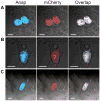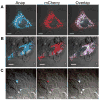A genetically encoded fluorescent probe in mammalian cells
- PMID: 23924161
- PMCID: PMC3783214
- DOI: 10.1021/ja4059553
A genetically encoded fluorescent probe in mammalian cells
Abstract
Fluorescent reporters are useful in vitro and in vivo probes of protein structure, function, and localization. Here we report that the fluorescent amino acid, 3-(6-acetylnaphthalen-2-ylamino)-2-aminopropanoic acid (Anap), can be site-specifically incorporated into proteins in mammalian cells in response to the TAG codon with high efficiency using an orthogonal amber suppressor tRNA/aminoacyl-tRNA synthetase (aaRS) pair. We further demonstrate that Anap can be used to image the subcellular localization of proteins in live mammalian cells. The small size of Anap, its environment-sensitive fluorescence, and the ability to introduce Anap at specific sites in the proteome by simple mutagenesis make it a unique and valuable tool in eukaryotic cell biology.
Figures




References
-
- Giepmans BNG, Adams SR, Ellisman MH, Tsien RY. Science. 2006;312:217–224. - PubMed
-
- Tsien RY. Annu Rev Biochem. 1998;67:509–544. - PubMed
-
- Zhang J, Campbell RE, Ting AY, Tsien RY. Nat Rev Mol Cell Biol. 2002;3:906–918. - PubMed
-
- Stadler C, Rexhepaj E, Singan VR, Murphy RF, Pepperkok R, Uhlén M, Simpson JC, Lundberg E. Nat Methods. 2013;10:315–23. - PubMed
-
- Hinner MJ, Johnsson K. Curr Opin Biotechnol. 2010;21:766–76. - PubMed
Publication types
MeSH terms
Substances
Grants and funding
LinkOut - more resources
Full Text Sources
Other Literature Sources
Research Materials
Miscellaneous

